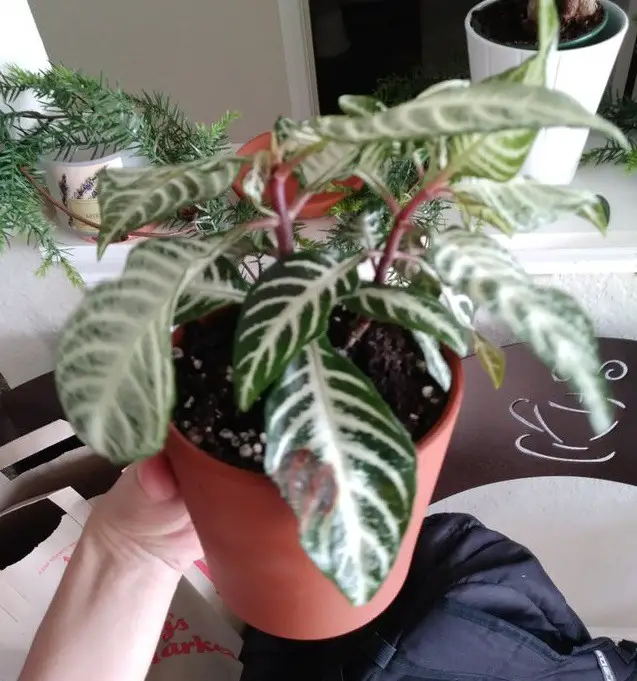Zebra plants are ideal for both indoor and outdoor spaces. These plants with zebra-like patterns on their leaves can tolerate different growing conditions. Brown spots on zebra plant leaves happen for many reasons.
So, why are there brown spots on the leaves of my zebra plant? The common causes of brown spots on zebra plant leaves are direct sunlight exposure, low humidity, watering problems, leaf spot disease, over-fertilization, and pest infestation.
Most of these causes are preventable and correctible. Take the time to read through the article to identify the exact causes before fixing it. Exercise ultimate zebra plant care to prevent the issue from happening in the future.
You May Also Like: How to Care for Philodendron Imperial Green

Reasons for Brown Spots on Zebra Plant Leaves
Direct Sunlight Exposure
The Zebra plant is a tropical houseplant growing under the canopy in its native habitat. It can tolerate low light conditions for a short period.
Direct sunlight exposure for an extended period can burn or scorch the leaves. Brown spots on leaves are the leading symptoms of scorching or burning.
Relocate the zebra plant to a place that receives bright indirect sunlight. It will help prevent burning or scorching the zebra plant leaves.
Low Humidity
Lack of humidity will make the zebra plant develop crispy leaves with brown spots. Other symptoms of low humidity are leaves curling and dropping off.
A combination of low humidity and direct sunlight exposure will result in severe problems. I recommend increasing the air moisture around the zebra plant.
Use a digital hygrometer to detect indoor humidity changes. Always mist the zebra plant leaves with distilled water to increase the humidity around the houseplant.
Another excellent option is to use an electric humidifier to increase indoor humidity. The golden rule is to replicate the tropical rainforest humidity at home.
Insect Infestations
Zebra plants are more vulnerable to spider mites, scales, mealybugs, and aphids. These sap-sucking creatures are responsible for the little brown speckles on the leaves.
Fine webbing and molted leaves on the undersides are indicators of spider mites. I recommend washing the leaves with room temperature water to control pest infestations.
Besides that, maintain high indoor humidity with bright indirect lighting and proper ventilation to discourage pests from spreading.
Another perfect choice is to spray insecticidal soap solution to the houseplant. Continue spraying the plant for weeks until all the pests are killed.
Leaf Spot Diseases
Rust usually results in brown spots with brown rings underneath the zebra plant leaves. It is a fungal growth that thrives in a wet environment. Brown spots are a collection of fungal spores.
Bacterial leaf spots cause sunken and wet-looking brown spots on the zebra plant leaves. It is due to overwatering, high humidity, and poor ventilation.
Fungal leaf spot causes brown spots with yellow edges on the zebra plant leaves. Remove the affected leaves and apply neem oil spray to treat the fungal disease.
Do not mist the zebra plant leaves in a low lighting condition and poor ventilation. It will help to combat brown spots on the leaves of zebra plants.
Watering Problem
Brown leaf tips or brown dying leaves are a sign of inconsistent watering habits. Dry soil can also cause zebra plant leaves to fall off or curl.
Soak the potting soil after inspecting the moisture content. Develop a strict watering schedule to prevent brown spots on the zebra plant leaves.
Be sure to reduce watering frequency during winter due to the dormancy phase. The plant will use less water and result in a waterlogged environment.
Water Quality Issue
Tap water contains chlorine and fluoride minerals. These compounds settle on the leaves after misting or watering the houseplant. These minerals later cause brown spots on zebra plant leaves.
Use distilled water or rainwater to irrigate or mist your zebra plant. It will help prevent the formation of brown spots on the leaves. Remember to clean the dust and dirt from zebra plant leaves.
Fertilizer Application Problem
Too much salt buildup in the potting soil is responsible for the brown zebra plant leaf tips. These crusty substances usually appear on the topsoil.
Flush the potting mix thoroughly with distilled water to remove the excess salt. Sink the pot in water instead of running water over the potting soil.
Always feed the zebra plant every 2-3 months during spring and summer. Do not feed the houseplant during fall and winter due to the dormancy phase.
You May Also Enjoy:
Related Questions
Why Are My Zebra Plant Leaves Falling Off?
Inappropriate watering routine is the leading cause of zebra plant leaves falling off. Other possible causes are over-fertilization and extreme temperatures.
Why Does My Zebra Plant Have Brown Spots?
Leaf spot diseases are the reasons behind the brown spots on zebra plant leaves. Improve air circulation around the plant and keep the zebra plant leaves dry.
Why Are My Zebra Plant Leaves Turning Yellow?
Zebra plant leaves turning yellow are due to incorrect lighting, overwatering, transplant shock, acclimation, and many others. Inspect your plant to identify the exact cause before fixing it.
Why Is My Zebra Succulent Leaves Turning Brown?
Direct sunlight exposure, over-fertilization, and under-watering are the main causes of zebra succulent leaves turning brown. Examine your zebra succulent to identify the exact cause.
You May Also Read: How to Care for Pilea Glauca
Final Thoughts
The golden rule is to troubleshoot the brown spots on the zebra plant leaves before fixing them. It can be challenging to figure the exact causes of your zebra plant.
Take the time to observe your zebra plant and review its care requirements. The step will make it easy to identify the exact causes for easy fixing.
Isolate the zebra plant from other houseplants. It will help to combat plant diseases from spreading to others. I hope this article will help you figure out the exact causes and solutions.
